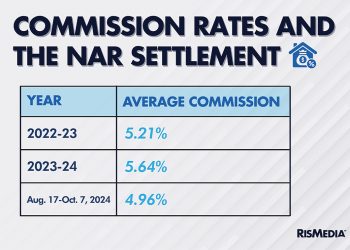Year-over-year rent growth fell to 8.2%, the lowest level since the summer of 2021 and down from its 15.3% peak in the first quarter, according to a new Yardi Matrix report released this week.
Yardi Matrix’s latest National Multifamily Report found that U.S. asking rents increased $3 in October to $1,727. The report also found that the single-family rental market is cooling, with the average asking rent unchanged at $2,088 in October, and YoY increase fell by 160 basis points to 6.6%.
Key highlights:
- Month-over-month rent growth was led by New York (0.8%), Indianapolis (0.7%), Kansas City (0.6%) and Portland (0.5%).
- Once again there was a bifurcation of property quality. Sixteen of the Top 30 metros recorded negative growth in the Lifestyle category, led by Las Vegas (-0.8%), Sacramento (-0.6%) and the Inland Empire (-0.5%). Meanwhile, only four metros saw negative growth in Renterby-Necessity units.
- Only five of the Matrix top 30 metros produced double-digit YoY rent growth: Indianapolis (11.8%), Orlando (11.6%), Miami (11.4%), San Jose (10.6%) and Dallas (10.5%).
- National lease renewals fell in September to 60.2%, continuing a slide from the peak of 68.0% in the fourth quarter of 2021.
- Metros with the highest lease renewal rates in September include Philadelphia (73.8%), Kansas City (67.9%) and Baltimore (66.9%), while renewal rates were lowest in West Coast metros Los Angeles (41.6%), San Francisco (43.1%), San Jose (43.9%) and Seattle (50.2%).
- National renewal rents increased 10.9% on a YoY basis in September, a 10-basis point decline from August. Renewal rents are now rising faster than overall rent growth.
- The rental occupancy rate has dropped 50 basis points over the past year, but the national 95.5% rate remains above the long-term average. Occupancy rates of stabilized properties are negative YoY in 24 of the Top 30 metros, and occupancies have fallen at least 0.5% in 19 of them.
- Metros in which occupancy rates have dropped by at least 1.0% YoY include the Inland Empire (-1.0%), Tampa and Atlanta (-1.1%), Sacramento (-1.3%), and Phoenix and Las Vegas (-1.8%).
Major takeaway:
The report stated that the deceleration in asking rents remains gradual, as every one of the Matrix top 30 metros produced year-over-year rent increases. But there are worries about how the multifamily market will react to the rapid increase in short-term interest rates as the Federal Reserve attempts to reduce inflation.
“The inevitable economic slowdown raises questions about when the impact will start to be felt and how much the sector will be affected,” said the author of the report. “Demand has weakened since the first quarter due to slowing job growth and concerns over the macroeconomic environment. The robust household formation that drove demand in 2021 is no longer in effect.”
For the full report, click here.











